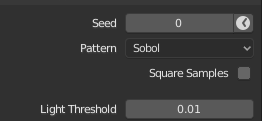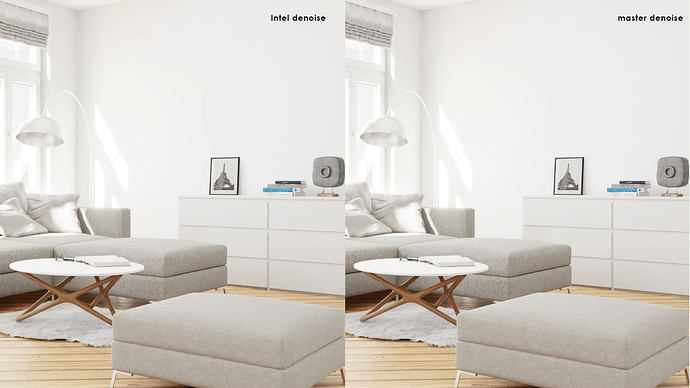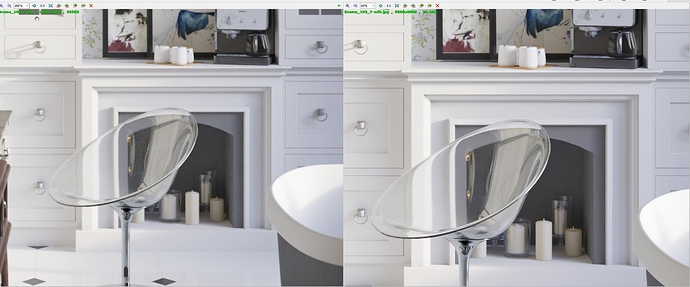I’m trying to render large (20x20k) images & the AI denoiser can’t seem to handle it. I’m c rashing in the compositing phase. Is this a memory issue on my pc? How do I handle these renders? I’ve got 32gb system ram
Hi,
since March, the memory usage of the AI denoiser was already cut by 2, but AI require a lot of memory in general. At this resolution, even the level 1 and 2 will crash if you don’t have enough memory.
- A solution if you have a big SSD is to increase the Swap/pagefile size to something like 256GB.
- Another solution is to use crops of the image to feed the network.
Intel should release a version which require 33% less memory in the coming weeks and I have some proof of concept code improving the efficiency further, to allow to easily denoise high res renders.
Hey, thanks a bunch bro! That seemed to do the trick (Keep User Interface and minimizing)… Now we just need to see if it works for longer animations…
Hmmm… I just realized that my E-Cycles Quick Settings is giving me a Missing Paths when I click on it…
Fixed in the 20190506 beta 
It is surprising it doesn’t automatically tile. When dealing with this sort of technique, it is necessary to have overlapping tiles, but it is still quite straightforward to implement and the memory requirements can be reduced and even controlled quite easily.
Actually it’s exactly what I’m doing, it’s just I have thousands other things to do and I first have to make the May update stable.
Thank you very much. 
Hi Mathieu,
E-Cycles is so amazing! I Love it. Here are my results from my personal scene.
(Everything was rendered with auto tile size.)
900 AA Samples:
9min 17sek. = Master
4min 14sek. = E-cycles “May”
4min 31sek. = E-cycles “April”
900 AA Samples + master denoise:
10min 35sek. = Master
04min 07sek. = E-cycles “May”
06min 42sek. = E-cycles “April”
900 AA Samples + intel denoise:
04min 31sek. = E-cycles “May”
06min 46sek. = E-cycles “April”
In my Scene the master-denoiser is faster. The auto tile size chooses 240 tiles to render instead of 3600 tiles like on the intel denoiser.
Rendering was GPU only:
1x RTX 2080
2x RTX 2070
If you are interested in comparing the denoise results here is a picture.
I’d recomend you to use A.I. Gigapixel to upscale static render, it’s much faster and more reliable in case with 20k images.
Hi Oliver,
thanks for the feedback. 10min35 to 4min07, that’s 2,59x faster than master with denoising and multiple GPUs 
When using more than 576spp (24 square), the old denoiser is better most of the time indeed. The Intel denoiser excels with low spp renders. In the comparison, it looks like you used the level 2 ? Level 3 is a bit slower but gives much better results, allowing to use lower spp. Most of the time, 400spp are enough with level 3, so it could in the end be faster than the master-denoiser.
The number of tiles is correct. The AI denoiser however uses your CPU and if system memory is not big enough, maybe it even uses slower pagefile, which can explain the slower render. But most of the time, as it allows to use half the sample, it compensates and the final render time is still better with AI.
I should add some more professionals interiors benchmark to better reflect real speed benefits from E-Cycles like in your case. I still have one manual feature to port from the 2.79 version that could bring 10% speedup, upping your results to 2,85x faster.
Hi Yuri,
do you have some examples of upscaling on renderings compared to full renders (like 10k upscaled to 20k vs fully path traced 20k) I only have seen examples of real photos until now.
I am using the Level 3 Denoiser. ( I have 64 GB Ram so it fits in my memory). I am using so many Samples because this Scene is an animation. With both denoisers i have the problem of “seeing ants” in the final result. I mean some kind of artefacts in the darker parts of the image like under the couch.
Indeed for animation, high samples are still needed in many cases. Try using the AO trick if you can and a low scrambling distance. It really helps the denoisers (both of them) and in animations the eye is very forgiving.
Here are my settings for the render:

Master:
Intel:
Do you know when the animation-denoising will come to the Blender Interface? Right now it is only avaiable per Comand line. (I mean the Master denoiser)
Will the Intel deoniser become better any Time soon with animation-denoising?
No, I don’t and I won’t.
I think 20k images are used for printing, so A.I. uprezing should be fine here. I used it to uprez 4k to 8k image for a local indusctrial project and it was fine.
It works with sequences too, so if the source image has enough details to avoid obvious artifacts, it’s a good way to cut off render time significantly
you may upload it to imgur
thats an amazing upscale, 4k to 8k ? what software did you use AI gigapixel ?
I’m not sure about the resolution of this demo. I guess it’s just 1k to 2k.
A fellow from cg chat shared this to show the A.I. Gigapixel potential for cgi purposes.
Here is mine. 2k to 8k uprez. For a generic case it should be okay. But it depends on the input a lot.
I always use A.I Gigapixel for any render > 2K (Render in 2K upscale to any resolution)
The settings already look pretty good. As the camera is not moving but the noise does, it looks like the animation random seed is active?

See the small clock symbol at the top right, check it’s deactivated and it should be better.

